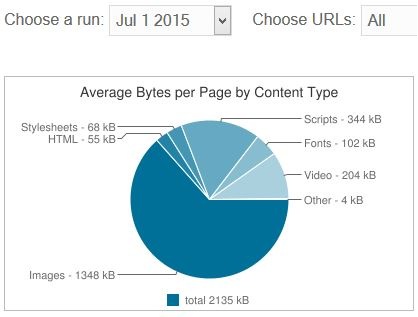We live in a world where we expect instant gratification, especially when it comes to the quality of our internet experience. From the ability to have 24/7 access to our financial accounts, “one-click” shopping on eCommerce sites, and of course, searching for answers to the boundless array of questions we have on a daily basis.
However, as quickly as we can access this information right at our fingertips, there is a slight speed bump in doing so. Believe it or not – you aren’t being impatient. The Internet is getting slower and just about everyone is noticing.
So what’s part of the cause for this issue? Page bloat and unoptimized images.
Unoptimized Images Are Bogging Down the User Experience
People browsing the web expect a similar experience to a fast-paced HD TV channel, with intensive graphics, animations and other visual assets, and site designers have largely obliged.
However, there’s been a push-pull dynamic: people also expect websites to load as quickly as the changing of a channel, serving bright, high-resolution images in real-time.
According to data from HTTP Archive, the average website is now 2.1 MB which is twice as large as the average website in 2012. Images, scripts and video make up most of that space.

Source: HTTP Archive
What isn’t helping the cause is the proliferation of smartphones, tablets and even watches that can access the Internet, which lead to incredible fragmentation.
All of these devices come with marketing campaigns promising portable powerhouses and break-neck speed, but don’t speak to the real-world bottlenecks in play, from browsers to bandwidth.
And the Solution Is…?
While coverage of the issues present the challenges adequately, they don’t address the steps that can be taken to address the problem.
If they did, you’d be reading about automation solutions. Using the right web performance optimization (WPO) solution enables faster websites and web-based applications, optimizes images on the fly, and selects the most effective image compression format that the browser can support.
It’s an elegant solution to a complex challenge, but can yield serious gains on Time to Interact (TTI), the measurement of the total load time between the first request and the point where the feature image loads and/or interactive elements can be engaged with. This is a key metric, and the real gauge for site speed.
So, when you are feeling a bit impatient that you’re website isn’t loading quickly enough, remember – it's not you. Web pages simply aren’t loading as quickly as they used to. Just know that an automation solution can address the spinning wheel of interminable loading.
Kent Alstad is VP of Acceleration at Radware.
The Latest
The use of hybrid multicloud models is forecasted to double over the next one to three years as IT decision makers are facing new pressures to modernize IT infrastructures because of drivers like AI, security, and sustainability, according to the Enterprise Cloud Index (ECI) report from Nutanix ...
Over the last 20 years Digital Employee Experience has become a necessity for companies committed to digital transformation and improving IT experiences. In fact, by 2025, more than 50% of IT organizations will use digital employee experience to prioritize and measure digital initiative success ...
While most companies are now deploying cloud-based technologies, the 2024 Secure Cloud Networking Field Report from Aviatrix found that there is a silent struggle to maximize value from those investments. Many of the challenges organizations have faced over the past several years have evolved, but continue today ...
In our latest research, Cisco's The App Attention Index 2023: Beware the Application Generation, 62% of consumers report their expectations for digital experiences are far higher than they were two years ago, and 64% state they are less forgiving of poor digital services than they were just 12 months ago ...
In MEAN TIME TO INSIGHT Episode 5, Shamus McGillicuddy, VP of Research, Network Infrastructure and Operations, at EMA discusses the network source of truth ...
A vast majority (89%) of organizations have rapidly expanded their technology in the past few years and three quarters (76%) say it's brought with it increased "chaos" that they have to manage, according to Situation Report 2024: Managing Technology Chaos from Software AG ...
In 2024 the number one challenge facing IT teams is a lack of skilled workers, and many are turning to automation as an answer, according to IT Trends: 2024 Industry Report ...
Organizations are continuing to embrace multicloud environments and cloud-native architectures to enable rapid transformation and deliver secure innovation. However, despite the speed, scale, and agility enabled by these modern cloud ecosystems, organizations are struggling to manage the explosion of data they create, according to The state of observability 2024: Overcoming complexity through AI-driven analytics and automation strategies, a report from Dynatrace ...
Organizations recognize the value of observability, but only 10% of them are actually practicing full observability of their applications and infrastructure. This is among the key findings from the recently completed Logz.io 2024 Observability Pulse Survey and Report ...
Businesses must adopt a comprehensive Internet Performance Monitoring (IPM) strategy, says Enterprise Management Associates (EMA), a leading IT analyst research firm. This strategy is crucial to bridge the significant observability gap within today's complex IT infrastructures. The recommendation is particularly timely, given that 99% of enterprises are expanding their use of the Internet as a primary connectivity conduit while facing challenges due to the inefficiency of multiple, disjointed monitoring tools, according to Modern Enterprises Must Boost Observability with Internet Performance Monitoring, a new report from EMA and Catchpoint ...





